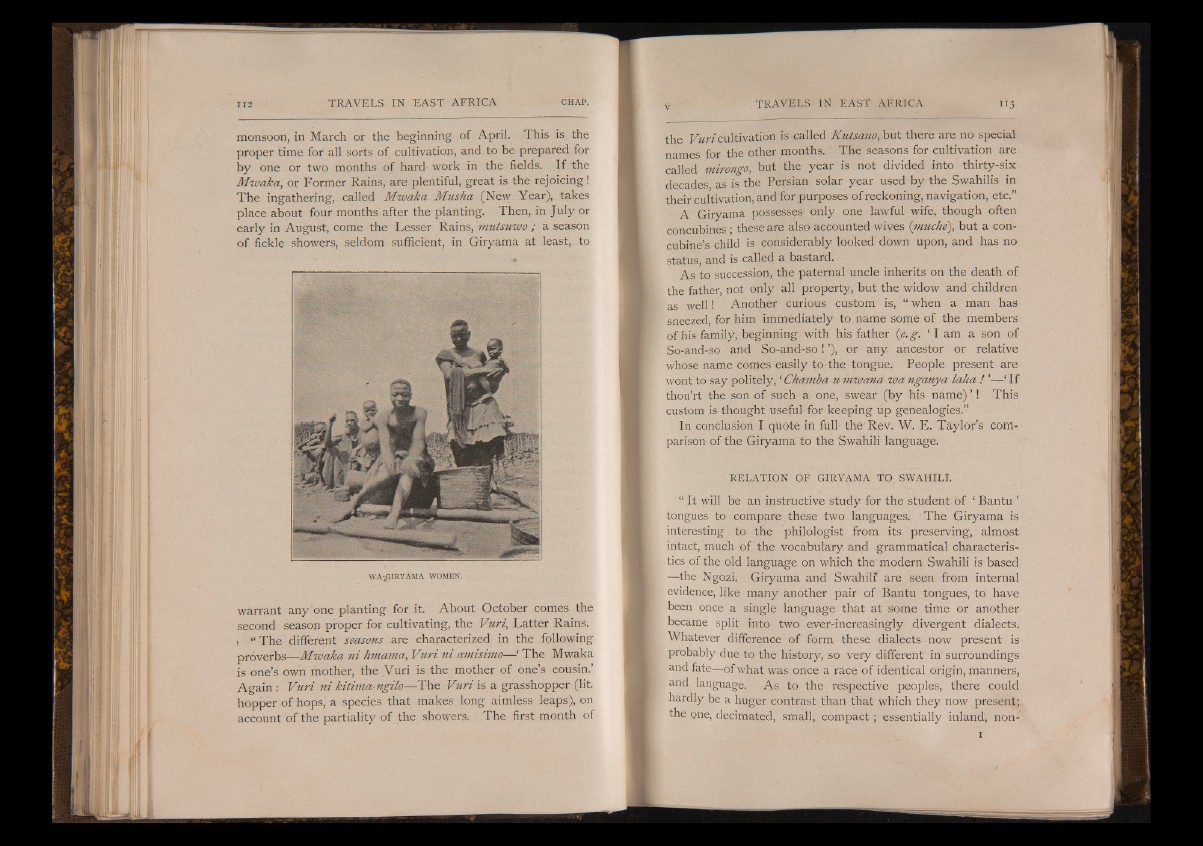
monsoon, in March or the beginning of April. This is the
proper time for all sorts of cultivation, and to be prepared for
by one vor two months of hard- work in the fields. If the
Mwaka, or Former Rains, are plentiful, great is the rejoicing!
The ingathering, called Mwaka Musha (New Year), takes
place about four months after the planting. Then, in July or
early in August, come the Lesser Rains, mutsuwo ; a season
of fickle showers, seldom sufficient, in Giryama at least, to
W A jG IR Y AM A WOMEN.
warrant any one planting for it. About October comes the
second season proper for cultivating, the Vuri, Latter Rains.
. “ The different seasons are characterized in the following
proverbs— Mwaka ni hmama, Vuri ni amisimo— ‘ The Mwaka
is one’s own mother, the Vuri is the mother of one’s cousin.’
Again : Vuri ni kitima-ngilo— The Vuri is a grasshopper (lit.
hopper of hops, a species that makes long aimless leaps), on
account of the partiality of the showers. Thè first month of
the Vuri cultivation is called Kutsano, but there are no special
names for the other months. ' The seasons for cultivation are
called mirongo, but the year is not divided into thirty-six
decades as is the Persian solar year used by the Swahilis in
their cultivation, and for purposes of reckoning, navigation, etc.”
A Giryama possesses only one lawful wife, though often
concubines; these are also accounted wives (muche), but a concubine’s
child is considerably looked down upon, and has no
status, and is called a bastard.
As to succession, the paternal uncle inherits on the death of
the father, not only all property, but the widow and children
as well! Another curious custom is, “ when a man has
sneezed, for him immediately to name some of the members
of his family, beginning with his father {e.g. ‘ I am a son of
So-and-so and So-and-so! ’), or any ancestor or relative
whose name comes easily to the tongue. People present are
wont to say politely, ‘ Chamba u mwana wa nganya laha ! ’— ‘ I f
thou’rt the son of such a one, swear (by his name) ’ ! This
custom is thought useful for keeping up genealogies.”
In conclusion I quote in full the Rev. W. E. Taylor’s comparison
of the Giryama to the Swahili language.
RELATION OF GIRYAMA TO SWAHILI.
“ It will be an instructive study for the student of ‘ Bantu ’
tongues to compare these two languages. The Giryama is
interesting to the philologist from its preserving, almost
intact, much of the vocabulary and grammatical characteristics
of the old language on which the modern Swahili is based
-"-the Ngozi. Giryama and Swahilf are seen from internal
evidence, like many another pair of Bantu tongues, to have
been once a single language that at some time or another
became split into two ever-increasingly divergent dialects.
Whatever difference of form these dialects now present is
probably due to the history, so very different in surroundings
and fate— of what was once a race of identical origin, manners,
and language. As to the respective peoples, there could
hardly be a huger contrast than that which they now present;
the one, decimated, small, compact; essentially inland, non